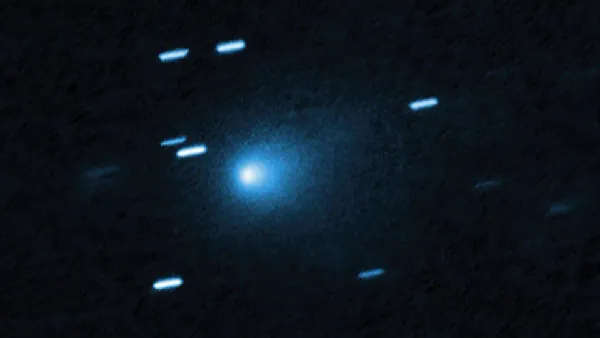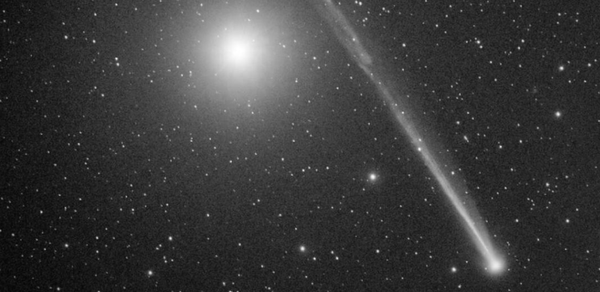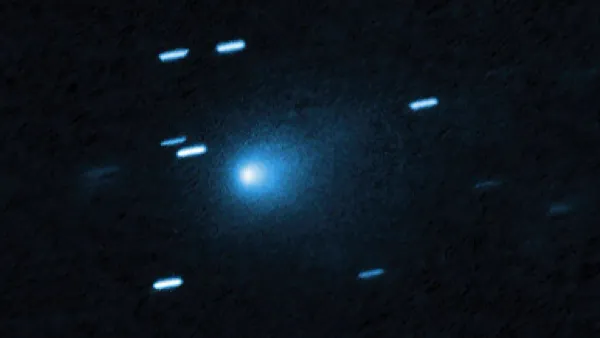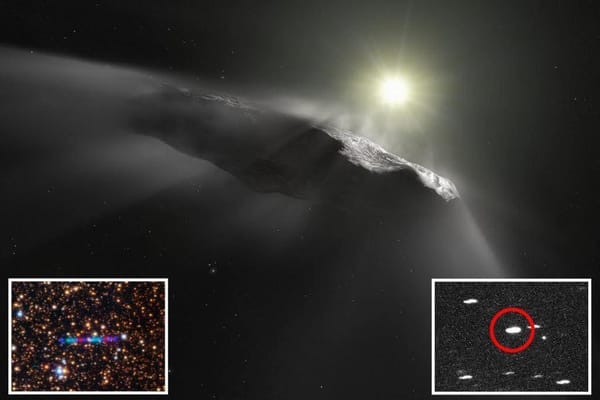The discovery of 3I/ATLAS, the third confirmed interstellar object to visit our solar system, has sparked fascination and curiosity among astronomers and the public alike. This icy wanderer, hurtling through our cosmic neighborhood at breakneck speed, has prompted a critical question: Are we safe from this interstellar comet? In this comprehensive exploration, we’ll delve into the nature of 3I/ATLAS, its trajectory, its physical properties, and the scientific consensus on its threat level—or lack thereof. Spoiler alert: Earth is in no danger, but the story of this cosmic visitor is a thrilling journey through astronomy, planetary defense, and the mysteries of the universe.
The Discovery of 3I/ATLAS: A Cosmic Intruder
On July 1, 2025, the Asteroid Terrestrial-impact Last Alert System (ATLAS) telescope in Río Hurtado, Chile, detected a faint, fast-moving object in the night sky. Initially cataloged under the temporary designation A11pl3Z, it appeared as a potential near-Earth asteroid, raising brief concern among planetary defense teams. The ATLAS system, designed to spot objects that could pose a collision risk with Earth, flagged the object for further scrutiny, landing it on the International Astronomical Union’s (IAU) Near-Earth Object Confirmation Page.
Follow-up observations from observatories worldwide, including contributions from amateur astronomers and major facilities like the Pan-STARRS telescope in Hawaii, quickly revealed that this was no ordinary space rock. Its orbit was hyperbolic, meaning it wasn’t bound by the Sun’s gravity and was moving too fast to belong to our solar system. With an excess velocity of approximately 58 km/s (36 mi/s), the object was identified as an interstellar visitor, only the third of its kind after 1I/’Oumuamua in 2017 and 2I/Borisov in 2019. Officially named 3I/ATLAS, it was confirmed as a comet, not an asteroid, due to the detection of a faint coma—a cloud of gas and dust surrounding its icy nucleus.
At the time of discovery, 3I/ATLAS was 4.5 AU (astronomical units, where 1 AU is the average Earth-Sun distance, about 150 million km or 93 million miles) from the Sun, roughly within Jupiter’s orbit, and approximately 3.5 AU (524 million km or 325 million miles) from Earth. Its origin point, near the constellation Sagittarius in the direction of the Milky Way’s Galactic Center, made it challenging to spot earlier due to the dense star field. Pre-discovery images from ATLAS later confirmed its presence as early as June 2025, but its faintness and rapid motion delayed its detection.
The question on everyone’s mind: Could this interstellar comet pose a threat to Earth? To answer, we need to examine its trajectory, physical characteristics, and the broader context of interstellar objects passing through our solar system.
The Trajectory: A Safe Flyby
One of the most reassuring aspects of 3I/ATLAS is its well-characterized orbit, which rules out any possibility of a collision with Earth. The comet is following a hyperbolic trajectory, meaning it’s not orbiting the Sun like planets or typical comets but instead making a one-time pass through our solar system before exiting back into interstellar space. This path is driven by its high velocity, which exceeds the Sun’s escape velocity at its current distance.
Key Orbital Milestones
- Discovery (July 1, 2025): At 4.5 AU from the Sun, 3I/ATLAS was already moving swiftly, with its hyperbolic orbit indicating an interstellar origin.
- Closest Approach to Mars (October 3, 2025): The comet will pass near Mars at a safe distance, offering a prime opportunity for observation by spacecraft like ESA’s Mars Express and NASA’s rovers and orbiters. The exact distance hasn’t been specified in available data, but it’s close enough to allow detailed study without risk to Martian assets.
- Perihelion (October 30, 2025): The comet will reach its closest point to the Sun at 1.4 AU (210 million km or 130 million miles), just inside the orbit of Mars. This is still well beyond Earth’s orbit, ensuring no direct interaction with our planet.
- Closest Approach to Earth (December 2025): 3I/ATLAS will pass Earth at approximately 1.8 AU (270 million km or 170 million miles), more than 1.5 times the Earth-Sun distance. This flyby occurs on the far side of the Sun, temporarily obscuring the comet from Earth’s view before it reappears in post-sunset skies.
- Exit from the Inner Solar System (Early 2026): By early 2026, 3I/ATLAS will fade from view as it speeds away, likely never to return.
Why the Distance Matters
The distance of 1.8 AU during its closest approach to Earth is a critical factor in assessing its safety. For context, this is farther than the orbit of Mars (1.5 AU) and vastly greater than the distance of potentially hazardous asteroids (PHAs), which are defined as objects passing within 0.05 AU (7.5 million km or 4.6 million miles) of Earth. Even at its closest, 3I/ATLAS will be so far away that it poses no gravitational or physical threat. Its passage on the Sun’s far side further reduces any immediate impact on Earth-based observations or systems.
Moreover, the comet’s high speed ensures it won’t linger. Unlike near-Earth asteroids that can remain in our vicinity for years, 3I/ATLAS is a transient visitor. Its hyperbolic orbit means it will exit the solar system entirely, making a collision not just unlikely but impossible based on current orbital calculations. NASA’s Center for Near-Earth Object Studies (CNEOS) and the European Space Agency’s (ESA) Near-Earth Object Coordination Centre have both confirmed that 3I/ATLAS is not on any impact watchlists.
Physical Characteristics: A Comet, Not a Threat
Understanding the physical nature of 3I/ATLAS further solidifies its harmlessness. Initially mistaken for an asteroid due to its faint, point-like appearance, subsequent observations revealed it to be a comet with a nucleus surrounded by a coma of gas and dust. This distinction is crucial, as comets are typically less dense and more volatile than asteroids, often breaking apart or losing mass as they approach the Sun.
Size and Composition
- Nucleus Size: Estimates of the comet’s nucleus vary, but Hubble Space Telescope observations on July 21, 2025, suggest a diameter of up to 5.6 km (3.5 miles). Harvard astronomer Avi Loeb has proposed it could be slightly smaller, around 5 km (3.1 miles), with a mass exceeding 33 billion tons. While this makes 3I/ATLAS the largest known interstellar object, its size is comparable to typical solar system comets like Halley’s Comet (about 11 km across).
- Coma and Dust: Spectroscopic data from ground-based telescopes and the James Webb Space Telescope (JWST) show a coma dominated by large, micrometer-sized dust grains with a reddish hue, likely due to irradiated organic compounds like tholins. The presence of a coma confirms the comet’s icy composition, as solar heating causes sublimation of ices into gas and dust.
- Chemical Makeup: JWST’s Near-Infrared Spectrograph detected significant carbon dioxide (CO₂) in the coma, alongside water ice in the nucleus. This CO₂ richness suggests 3I/ATLAS formed in a cold region of its parent star system, beyond the CO₂ ice line, where such ices could condense. These findings align with comets from our own solar system, posing no unusual risks.
Why Composition Matters
The comet’s icy, porous structure makes it less threatening than a solid, metallic asteroid of similar size. If, hypothetically, 3I/ATLAS were on a collision course (which it is not), its low density and tendency to fragment under solar heating would reduce the impact energy compared to a dense asteroid. However, its distance from Earth eliminates any such concerns entirely.
The reddish dust and CO₂ content also rule out exotic or artificial origins. A controversial paper by Avi Loeb speculated about the possibility of interstellar objects being “possibly hostile” alien technology, but the mainstream scientific community has dismissed this for 3I/ATLAS. Its cometary features—coma, dust tail, and ice sublimation—are hallmarks of a natural object, not an engineered one. As one astronomer quipped on X, “It’s just a dirty snowball, not a spaceship.”
Planetary Defense: How We Monitor Threats
The discovery and tracking of 3I/ATLAS highlight the robustness of our planetary defense systems, which are designed to identify and assess potential threats from near-Earth objects (NEOs). Systems like ATLAS, Pan-STARRS, and the upcoming Vera C. Rubin Observatory play a critical role in this effort.
The Role of ATLAS
The ATLAS network, funded by NASA, consists of telescopes in Hawaii, Chile, and South Africa, scanning the sky for moving objects. Its primary mission is to detect asteroids that could impact Earth, providing early warnings for objects as small as 30 meters (100 feet) across. The discovery of 3I/ATLAS demonstrates the system’s versatility, as it not only caught a non-threatening interstellar object but also distinguished it from hazardous NEOs.
Confirmation and Tracking
Once ATLAS flagged 3I/ATLAS, the global astronomical community sprang into action. Observatories like the Canada-France-Hawaii Telescope and the Zwicky Transient Facility provided precise astrometry, refining the comet’s orbit. The Minor Planet Center, operated by the IAU, cataloged the object and confirmed its interstellar nature. Continuous monitoring ensures that any deviations in its path—however unlikely—would be detected well in advance.
Future Preparedness
The Vera C. Rubin Observatory, set to begin its Legacy Survey of Space and Time (LSST) in 2026, will enhance our ability to detect interstellar objects and NEOs. Estimates suggest it could identify dozens of ISOs per year, compared to the current rate of one every few years. This will improve our understanding of these visitors and ensure we’re prepared for any that come closer than 3I/ATLAS.
NASA’s DART mission (2022) and ESA’s Hera mission (ongoing) demonstrate our growing capability to deflect hazardous asteroids if needed. While these technologies are irrelevant for 3I/ATLAS due to its safe distance, they underscore humanity’s proactive stance against cosmic threats.
Public Perception and Misinformation
Despite the scientific consensus that 3I/ATLAS is harmless, its discovery has sparked some public speculation and misinformation, particularly on platforms like X. Posts have ranged from excitement about its scientific value to unfounded claims of it being an alien probe or a potential impactor. Let’s address these concerns:
- Alien Technology? The idea that 3I/ATLAS could be an extraterrestrial artifact stems from earlier debates about 1I/’Oumuamua’s unusual shape and acceleration. However, 3I/ATLAS’s cometary features—coma, dust tail, and ice sublimation—clearly mark it as a natural object. No credible evidence supports an artificial origin.
- Impact Risk? Social media posts exaggerating the comet’s proximity have been debunked by astronomers. Its 1.8 AU closest approach is far too distant to affect Earth, and its orbit is precisely mapped.
- Hostile Intent? Fringe claims of “hostile” intent, as mentioned in one paper, are not taken seriously by the scientific community. 3I/ATLAS is a comet, behaving exactly as expected for an icy body warmed by the Sun.
Public outreach by NASA, ESA, and astronomers on X has helped clarify these points, emphasizing the comet’s scientific value over sensationalism. Educational campaigns, such as NASA’s updates on its NEO program, reinforce that 3I/ATLAS is a safe, exciting opportunity to study an interstellar visitor.
Scientific Opportunities: Why 3I/ATLAS Matters
While 3I/ATLAS poses no threat, its visit is a scientific bonanza. Interstellar objects offer a rare glimpse into the chemistry and dynamics of other star systems. Key questions being explored include:
- Origin: Where did 3I/ATLAS come from? Its trajectory from Sagittarius suggests it may have been ejected from a star system in the Milky Way’s disk, possibly billions of years ago. Its CO₂-rich composition hints at formation in a cold, distant region of its parent system.
- Composition: The comet’s water ice and carbon dioxide provide clues about the conditions in its home system. Comparing these to solar system comets could reveal how universal certain chemical processes are.
- Frequency: Estimates suggest seven ISOs pass within 1 AU of the Sun annually, but most go undetected. 3I/ATLAS’s discovery underscores the need for advanced surveys like LSST to catch more.
Observations by Hubble, JWST, and ground-based telescopes are ongoing, with data expected to yield insights into the comet’s nucleus, coma evolution, and potential fragmentation as it nears perihelion. While no spacecraft mission can intercept it due to its high speed (requiring a delta-v of 7 km/s from Earth), future missions like ESA’s Comet Interceptor could target similar objects.
Conclusion: A Safe and Fascinating Visitor
So, are we safe from 3I/ATLAS? Unequivocally, yes. The interstellar comet’s closest approach to Earth at 1.8 AU (270 million km or 170 million miles) in December 2025 is far too distant to pose any risk. Its hyperbolic orbit ensures it will exit the solar system by early 2026, leaving no lasting impact beyond its scientific legacy. Its cometary nature, with a porous, icy nucleus and a dusty coma, further reduces any hypothetical threat, and our planetary defense systems have confirmed its safe trajectory.
Far from being a danger, 3I/ATLAS is a gift to science—a fleeting messenger from another star system. As it brightens to magnitude 12–13, visible through modest telescopes in late 2025, it invites us to ponder our place in the cosmos. The universe is a busy place, with interstellar travelers passing through regularly. Thanks to vigilant monitoring and global collaboration, we can enjoy these visitors without fear, marveling at the stories they carry from distant stars.






